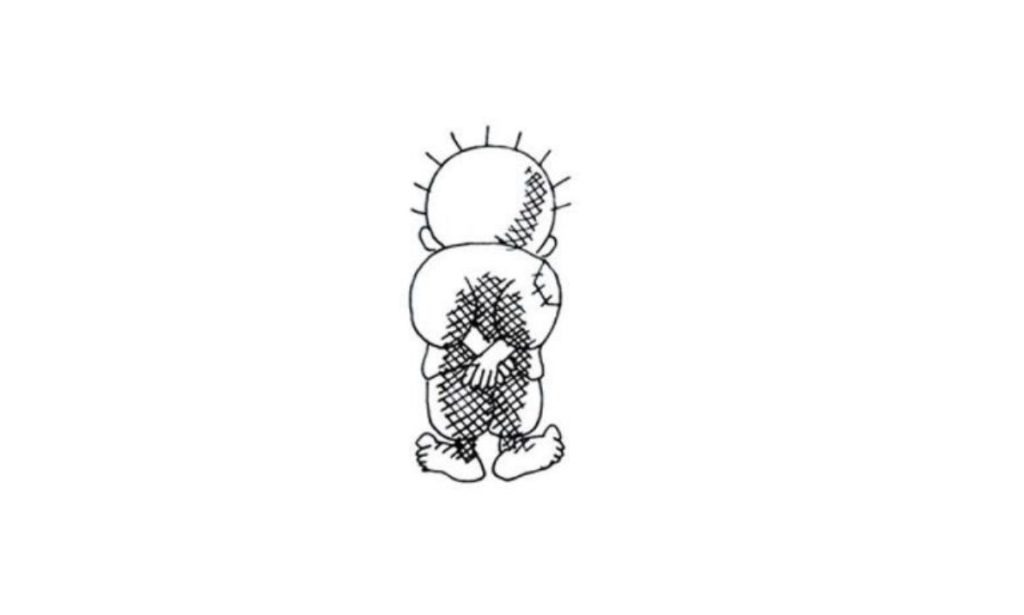It’s true that artists are not standing on the front line when it comes to the current genocide in Gaza. When it comes to immediate aid and rescue. Unlike doctors, journalists, and artists lead a different fight. Art has become a less immediate form of resistance. In times like this, art doesn’t become a luxury in itself for self-expression and reflection but takes the duty of echoing, representing, and owning the narrative.
Listed below are some of the countless masterpieces that the art scene has produced in a short period of time since October 7.
A Visual Representation of the Death Count in Gaza in October 2023
This Strikingly creative visual art piece was conceptualized by artist: Boutaina Azzabi
Makes use of the traditional Palestinian dress and turns it into a death map. This is metaphoric of the reality of Gaza, a city with a beautiful soul that has known and become dead. Each color represents a category of people, and the stitches of this color are the number of people martyred per category.
Al Suzani: Watermelons
Digital art by: Aziza Kadyri
What do watermelons have to do with Palestinian resistance? Or what does a slice of watermelon and a Palestinian flag have in common? The three colors of red, green, and black. Although the story is not confirmed, but watermelons have been used to substitute the Palestinian flag. It is said that during the 70s, an art collection referencing Palestine through realistic depictions of watermelons was confiscated. Some argue that Palestinians use it after Israel banns display their flag.
Palestinian Kufiyah
Artwork By: Issam Al Haj Ibrahim
Ibrahim looks at the iconic kufiyah unlike anyone else. He sees the netting as a large group of resistance men with their hands tied and their backs turned. It’s almost like a repetition of a thousand “Hanzalas.” Hanzala is the famous caricature of a child turning his back and standing in objection drawn by Nagy Al Aly.
Digital Art by: Haneen Nazzal
The artist posts this art piece on her Instagram account with the caption “If you know, you know”, so what’s the story behind it?
About a week ago, a video of Palestinian jihadi went viral on social media. In the video, the person whose face remains unknown, is seen dressed in Adidas sweat pants, a t-shirt, and a pair of slippers, crawling out of a tunnel with a missile in his hand. He targets Israeli tanks swiftly and then slides back into the tunnel.
Furthermore, the red triangle in the image, was not originally shown in the video but exists in official videos of the Hamas group. There are several interpretations of that red inverted triangle. Some say it simply refers to the red triangle on one side of the Palestinian flag; some go as far as seeing it as a development of dart, or a trace of the peace sign.
A similar illustration was painted by Egyptian painter Yassin
You Can’t Beat a Nation that knows death is not the end
Artwork by: Heba Tannous
Tannous created multiple sketches incorporating calligraphically text and quick strokes painting. Her favorite line is “Resistance is an Idea, and Ideas are eternal.” The background of the canvas is mortuary fridges from where colorful flowers are growing out of the bodies of the martyrs. Despite their death, the resistance still survives and that’s the way it has always been.
Tunnels
Artwork by: Sara Qaed
Another artwork referencing a sad moment in time. The wheelchair with two fragile arms remaining of the body symbolized Ahmed Yaseen, the Hamas leader who was targeted and killed by Israelis when he was an elderly man in his eighties. The idea is similar to the previous illustration since the chair on top of destroyed Israeli tanks refers to the survival of the idea of resistance.
Free Palestine
Artwork By: Hassan Manasrah
A Palestinian woman dressed in the traditional dress of most likely Yafa city, surrounded by symbols of everything Palestinian except that the olive tree is sprouting bullets. Something about this illustration is incredibly empowering, it could be the intersection of olive tree branches with the woman’s head, it could be the fact that she is wearing the Kufiyah as a headscarf, or the overall impression that she is standing statically with an inert facial expression.
What the artists are doing right now is impressive on so many levels. On one level, they are bringing, either intentionally or not, a new wave that uses symbolism intimate to Palestinians, and to Arabs in general which establishes a sense of belonging to a struggle that belongs to each and every Arab there is. On another level, these artists, who can not be summed up and given poetic justice in one article, are sustaining the resistance for decades to come. The immediacy of the impression present in each artwork here shall preserve itself for decades to come.
WE SAID THIS: Don’t Miss…Meet The 4 Young Palestinian Journalists Covering What CNN and BBC Could Not



